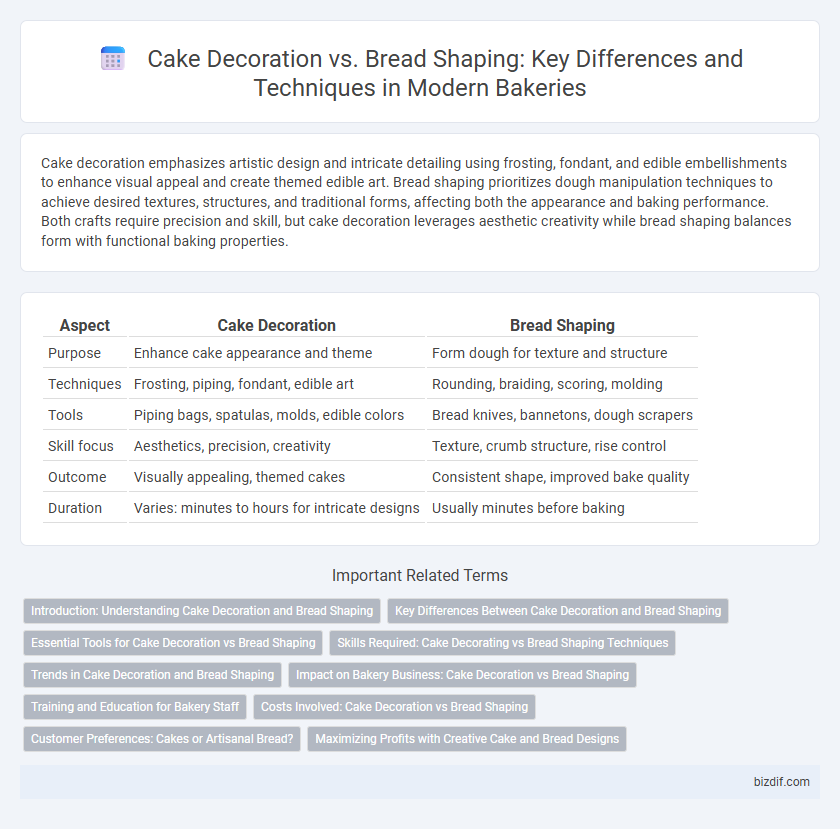Cake decoration emphasizes artistic design and intricate detailing using frosting, fondant, and edible embellishments to enhance visual appeal and create themed edible art. Bread shaping prioritizes dough manipulation techniques to achieve desired textures, structures, and traditional forms, affecting both the appearance and baking performance. Both crafts require precision and skill, but cake decoration leverages aesthetic creativity while bread shaping balances form with functional baking properties.
Table of Comparison
| Aspect | Cake Decoration | Bread Shaping |
|---|---|---|
| Purpose | Enhance cake appearance and theme | Form dough for texture and structure |
| Techniques | Frosting, piping, fondant, edible art | Rounding, braiding, scoring, molding |
| Tools | Piping bags, spatulas, molds, edible colors | Bread knives, bannetons, dough scrapers |
| Skill focus | Aesthetics, precision, creativity | Texture, crumb structure, rise control |
| Outcome | Visually appealing, themed cakes | Consistent shape, improved bake quality |
| Duration | Varies: minutes to hours for intricate designs | Usually minutes before baking |
Introduction: Understanding Cake Decoration and Bread Shaping
Cake decoration involves enhancing the visual appeal and flavor of cakes using techniques like icing, piping, fondant application, and edible embellishments to create intricate designs. Bread shaping focuses on forming dough into specific shapes before baking, influencing texture, crust development, and overall presentation through methods such as braiding, scoring, or molding. Both practices require skilled craftsmanship, but cake decoration emphasizes artistic creativity while bread shaping balances aesthetics with dough fermentation and baking science.
Key Differences Between Cake Decoration and Bread Shaping
Cake decoration emphasizes aesthetic enhancements using icing, fondant, and edible embellishments to create visually appealing designs, while bread shaping focuses on molding dough into specific forms to influence texture and baking properties. Cake decorators typically employ delicate, intricate techniques such as piping and sculpting, whereas bread bakers use methods like kneading, proofing, and scoring to develop crust structure and loaf volume. Both skills require precision, but cake decoration prioritizes artistic presentation, whereas bread shaping centers on functional dough development.
Essential Tools for Cake Decoration vs Bread Shaping
Essential tools for cake decoration include piping bags, various nozzles, turntables, and fondant smoothers, enabling intricate designs and smooth finishes on cakes. In contrast, bread shaping requires bench scrapers, proofing baskets, dough cutters, and scoring blades to create defined shapes and textures in artisanal bread. Both sets of tools play a crucial role in achieving the desired aesthetic and structural outcomes unique to their respective baking crafts.
Skills Required: Cake Decorating vs Bread Shaping Techniques
Cake decoration demands precision in piping, fondant shaping, and an artistic eye for color and design, while bread shaping requires mastery of dough consistency, tension control, and proving times to achieve perfect texture and form. Both crafts rely on manual dexterity, but cake decorators emphasize aesthetics and intricate details whereas bread shapers focus on structural integrity and crumb development. Advanced skills in cake decoration often involve specialized tools for sculpting edible decorations, contrasting with bread shaping techniques that prioritize traditional hand-kneading and folding methods.
Trends in Cake Decoration and Bread Shaping
Trends in cake decoration emphasize intricate designs using edible flowers, gold leaf, and vibrant buttercream techniques, reflecting a shift towards personalized and artisanal aesthetics. Bread shaping trends prioritize rustic and sculptural forms, such as braided loaves and sourdough boule with unique scoring patterns, highlighting artisanal craftsmanship and natural fermentation. Both cake decoration and bread shaping increasingly integrate sustainability by using organic ingredients and minimizing food waste in the bakery industry.
Impact on Bakery Business: Cake Decoration vs Bread Shaping
Cake decoration enhances visual appeal and customer attraction by offering highly customizable and trendy designs, driving higher profit margins through premium pricing. Bread shaping emphasizes artisanal craftsmanship and consistency, appealing to customers seeking traditional and rustic bakery experiences, which supports steady sales volume and brand loyalty. Both techniques impact the bakery business by diversifying product offerings and targeting different market segments for growth.
Training and Education for Bakery Staff
Effective training in cake decoration emphasizes skills such as intricate piping techniques, fondant application, and color harmony to enhance visual appeal. Bread shaping education prioritizes mastering dough handling, proofing control, and shaping varieties like baguettes or rolls to ensure texture and structure. Comprehensive bakery staff education integrates both disciplines to produce visually stunning and structurally sound baked goods.
Costs Involved: Cake Decoration vs Bread Shaping
Cake decoration typically involves higher costs due to specialized ingredients such as fondant, edible paints, and intricate sugar work, alongside the need for skilled labor and additional tools like airbrushes and piping bags. Bread shaping costs are generally lower, relying on basic dough manipulation techniques, minimal additional ingredients, and simpler tools like bannetons or shaping mats. The difference in costs also reflects the time intensity and expertise required, with cake decoration often demanding more precision and artistic skill compared to bread shaping.
Customer Preferences: Cakes or Artisanal Bread?
Customer preferences often lean towards cake decoration for celebrations due to its visual appeal and customizable designs, making it a popular choice for birthdays and weddings. Artisanal bread shaping attracts those who appreciate rustic aesthetics and unique textures, emphasizing natural ingredients and traditional baking techniques. Both cake decoration and bread shaping fulfill different desires, with cakes favored for artistic versatility and breads preferred for authentic craftsmanship.
Maximizing Profits with Creative Cake and Bread Designs
Creative cake decoration and innovative bread shaping techniques significantly enhance product appeal, driving higher sales and customer retention in bakeries. Utilizing intricate cake designs with vibrant frosting and edible art attracts event-specific orders, while unique bread shapes offer visual differentiation on shelves, encouraging impulse buys. Maximizing profits involves balancing time-efficient shaping methods with high-impact decorative elements to create diverse product lines that cater to varying customer preferences.
Cake Decoration vs Bread Shaping Infographic

 bizdif.com
bizdif.com